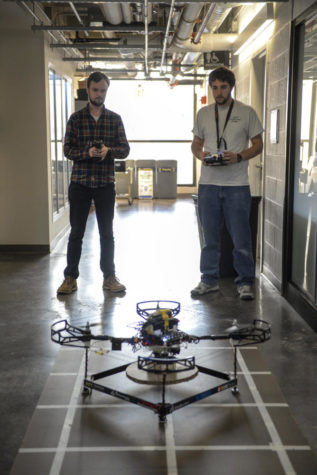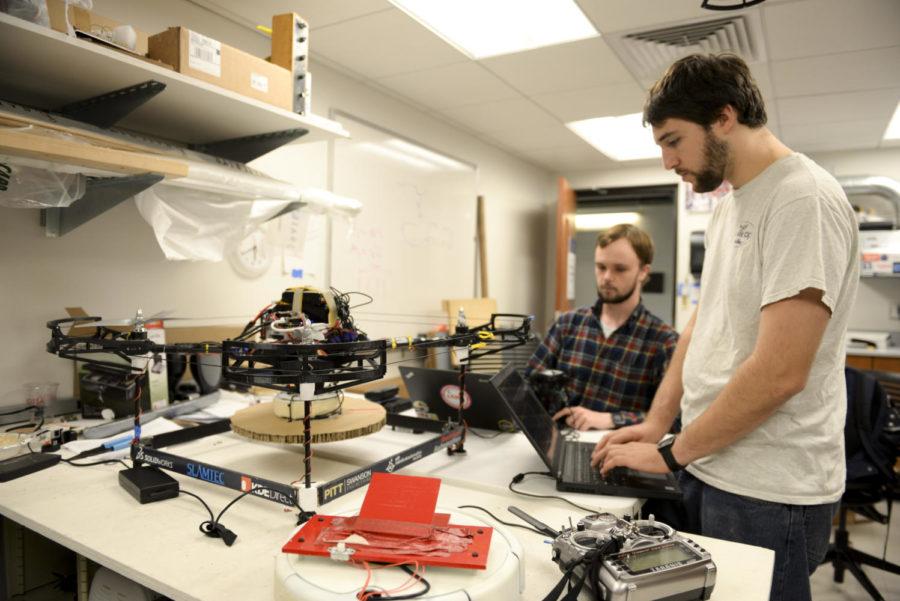Levi Burner had dreamed of making a flying machine since he was 8 years old.
The junior electrical engineering student finally got his chance when he started to build a drone for the International Aerial Robotics Competition more than a year ago.
“The fact that we have found a competition that follows that dream just gets me really excited,” Burner said. “I’ve always been a robotics fan, so I’ve been building robots since I was quite young.”
Burner, along with the Pitt Robotics and Automation Society, engineered a drone capable of flight to compete in the North American venue of the IARC, hosted at the Georgia Institute of Technology this past summer. The student group — which began work on the drone during the summer of 2016 — has since worked to improve their initial drone by developing its software and hardware so that it can compete again next summer.
In the robotics competitions — which hosted Pitt students last summer and will do so again next year — the Pitt group competes against other teams to complete Mission 7.The mission specifically involves developing a drone that is capable of herding a group of roombas — moving robots — like sheep, from one side of a 20 by 20 meter arena to the other.
The drone must navigate without the aid of a GPS, or by using its distance between large objects, to determine its relative position. There are also moving targets which the drone must avoid. Because no team successfully completed this task at the competition this past summer, the mission remains the same for the upcoming competition.

According to Burner, the type of technology developed for Mission 7 could have potential applications in search and rescue, the military and mapping. The group members also mentioned that their drone’s technology is similar to what Amazon is developing in its drone delivery system — and that both are working on more precise landings.
“[IARC’s Mission 7] aims to demonstrate something that cannot be done by a government or private entity — trying to demonstrate localization without global reference points,” Burner said.
The team that earns the most points overall for both IARC competition venues — the North American venue and the Asia/Pacific venue, hosted at Beihang University — wins the competition. While the Pitt team did not have the most points last summer, it received an award for best system design for earning the most points at the North American venue.
Liam Berti, a leader of the project and a senior electrical engineering student, worked on the drone’s circuit board, wiring and software.
“This was a fun-looking competition that would be challenging for us, so we decided to take a crack at it,” Berti said. “This quickly became a lot larger than anything we’ve done before.”
Starting with 20 members in the summer of 2016, the team has grown to more than 30 robotics enthusiasts. The seven leaders in the project — which include Burner and Berti — typically spend 20 hours per week developing the drone’s technology, while members are encouraged to work eight hours per week. But sometimes the project can be even more time-consuming.
“Over the summer, we pretty much lived in the robotics room, so easily 70 plus hours a week working on the drone, especially getting into later months,” Berti said of the lead-up to the competition.
For that competition, the team concentrated on building a nimble drone capable of flight. Now, with the award for best system design in hand, the group will focus on improving the drone’s herding ability.
The team faced several challenges while working toward their first goal — building the drone. One issue was unreliable thrusters — engines that help maneuver the drone — which affected the drone’s flight stability. The group also had several minor crashes while testing.
“Upkeep of the drone has always been a challenge,” said Burner. “We had to get very good in modifying the different parts when they were broken.”
The robotics team is currently working on the drone’s hardware so that it will be capable of carrying necessary sensors and equipment. The group is also working to develop artificial intelligence and obstacle detection software for the drone in preparation for eventual full-scale testing.
Aaron Miller, another team leader, is heavily involved in developing the drone’s software. The senior computer science and physics major will focus on its artificial intelligence and perception software this year, which will allow the drone to herd the moving robots in preparation for IARC’s next competition in July 2018.
“The IARC Competition we went to is international so there are teams from all over North America, so the level of competition at the IARC is much higher than any level of competition we’ve done before,” Miller said.
Burner attributed most of the team’s success this year at the IARC competition to the debates the members of the robotics team often have in order to bounce ideas off each other and figure out what works best. Miller said much of the knowledge required to build the drone is self-taught.
“A lot of the things we do are things we don’t learn in class. We taught ourselves a lot of these things,” Miller said. “And when we bring in new members, we try to pass those things on as they’re working on the project.”
Miller said the team has a lot of freedom with how to carry out the project, so spending the time to develop the technology demands a large amount of self-motivation — which he said most of the team members have.
“All of this stuff we’re doing outside of class, just because we think it’s cool. We don’t really do this to win the competition, although that’s a nice bonus,” Miller said.



